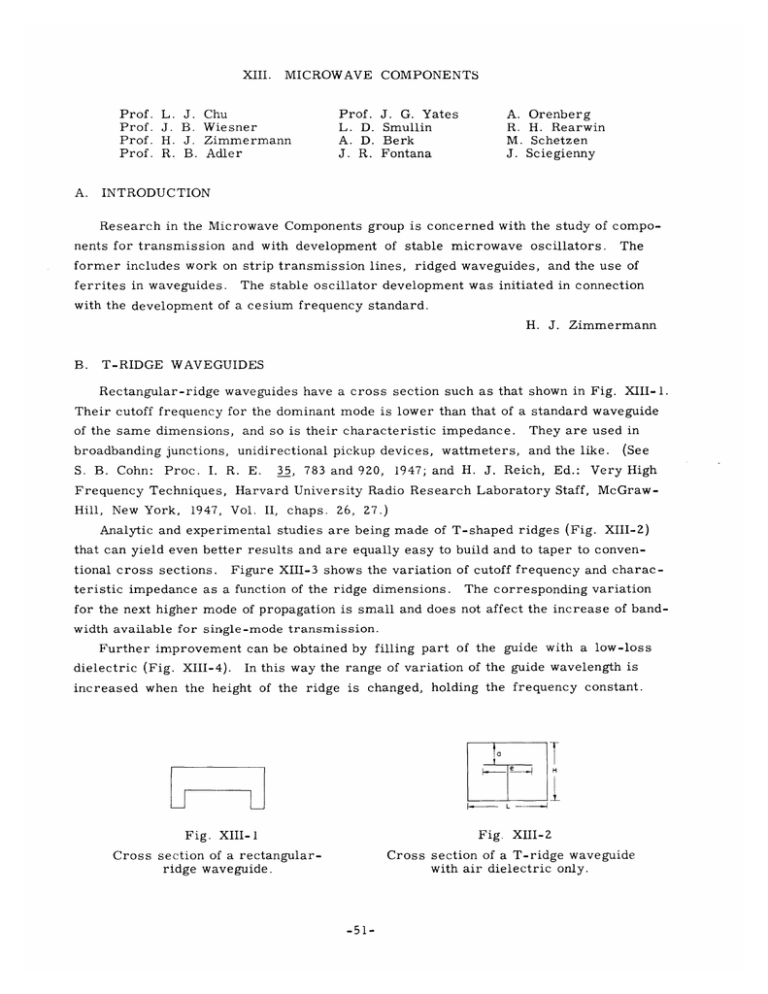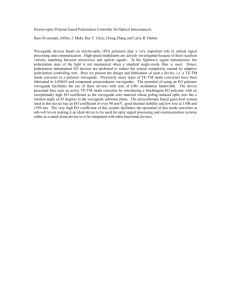XIII. MICROWAVE COMPONENTS Prof. L. J. Chu
advertisement

XIII. Prof. Prof. Prof. Prof. A. L. J. H. R. J. B. J. B. MICROWAVE Chu Wiesner Zimmermann Adler Prof. L. D. A. D. J. R. COMPONENTS J. G. Yates Smullin Berk Fontana A. R. M. J. Orenberg H. Rearwin Schetzen Sciegienny INTRODUCTION Research in the Microwave Components group is concerned with the study of compo- nents for transmission and with development of stable microwave oscillators. former includes work on strip transmission lines, ridged waveguides, ferrites in waveguides. The and the use of The stable oscillator development was initiated in connection with the development of a cesium frequency standard. H. J. B. Zimmermann T-RIDGE WAVEGUIDES Rectangular-ridge waveguides have a cross section such as that shown in Fig. XIII-1. Their cutoff frequency for the dominant mode is lower than that of a standard waveguide of the same dimensions, and so is their characteristic impedance. broadbanding junctions, unidirectional pickup devices, wattmeters, S. B. Cohn: Proc. I. R. E. Frequency Techniques, Hill, New York, 35, 783 and 920, 1947; and H. J. They are used in and the like. Reich, Ed.: (See Very High Harvard University Radio Research Laboratory Staff, McGraw- 1947, Vol. II, chaps. 26, 27.) Analytic and experimental studies are being made of T-shaped ridges (Fig. XIII-2) that can yield even better results and are equally easy to build and to taper to conventional cross sections. Figure XIII-3 shows the variation of cutoff frequency and charac- teristic impedance as a function of the ridge dimensions. The corresponding variation for the next higher mode of propagation is small and does not affect the increase of bandwidth available for single-mode transmission. Further improvement can be obtained by filling part of the guide with a low-loss dielectric (Fig. XIII-4). In this way the range of variation of the guide wavelength is increased when the height of the ridge is changed, holding the frequency constant. Fig. XIII-2 Fig. XIII-1 Cross section of a T-ridge waveguide with air dielectric only. Cross section of a rectangularridge waveguide. -51- H/L = 0.473 Zm = e/L 0.375 e/L= 0334 (fc/fi = e/L 0.300 SEEFIG =- 2 FORSYMBOLS Z e/L = 0 300 e/L= 0.334 e/L = 0.375 04 03 Fig. XIII-3 Cutoff frequencies and impedances for the lowest mode in T-ridge waveguides. (a (0)T (b) Fig. XIII-4 Cross sections of T-ridge waveguides with two dielectrics. L=72CM H f,=1880 MG/SEC\ SEC GE TEM (I "'00 0041. 00415 HTEM(2) 0 I 0l I I O/L Fig. XIII-5 Guide wavelengths of T-ridge waveguides with two dielectrics. -52- (XIII. Experimental MICROWAVE COMPONENTS) curves are shown in Fig. XIII-5 for the section of Fig. XIII-4(a). The shape of these curves can be modified by changing the dimensions of the ridge and the distribution of the dielectric to fit the requirements of various possible applications. On the basis of these results, a broadband junction between a coaxial cable and a It is expected to give a standing- T-ridge waveguide was designed and is being tested. wave ratio less than 2 over the range between 1200 Mc/sec and the cutoff frequency of the next propagating mode. J. C. Fontana FERRITES AT MICROWAVE FREQUENCIES A general approach for the solution of waveguide problems with anisotropic and cross-sectionally inhomogeneous media has been developed. It is fundamentally the same one used for the solution of cavity problems. Its essential merit is its applica- bility to approximate or perturbation calculations. Although the details of this method will not be given here, some of the results based on its application will be presented. 1. Square or Circular Waveguide Completely Filled with Ferrite If the steady magnetic field is oriented along the z-axis (axis of symmetry of the waveguide) the only elements of the magnetic susceptibility tensor Xm will be Xmxy = -jK, Xmyx = jK, Xmxx = X = X. We then have for the propagation constant of the two lowest modes, to the first order, + = (1) For a circular waveguide C = 0. 84; for a rectangular waveguide C z 0. 81. In this expression y' is the propagation constant of the lowest mode of a waveguide filled with a dielectric of permittivity equal to that of the ferrite. 2. Square or Circular Waveguide with a Sliver of Ferrite Along the Z-Axis If the steady magnetic field is again taken along the z-axis, we have, to the first order, = + W X + ± K) (2) where yo is the propagation constant of the lowest mode of the empty waveguide, Xe is the electric susceptibility of the ferrite, j is the cross-sectional S is that of the waveguide, area of the ferrite, C = 1 for the rectangular waveguide, and C = 1. 4 for the circular waveguide. -53- (XIII. MICROWAVE COMPONENTS) Fig. XIII-6 3. Rectangular Waveguide with a Thin Slab The components of the tensor permeability Xm are, in this case (see Fig. XIII-6), Xmx x = X X, X jK, X = -jK. The propagation constant is, to the first order, 6 K o I where y 2 4. k =k o s cos22 (/a2 - (ra) Tr , k2 k sin2 d 1O d - cos 2d d 2 2 + kZ 0 6 2 n e 2 a sin a d+ 6 ax (3) Comments The main perturbing factor of a ferrite is its large electric susceptibility (about 15). In problems where the ferrite completely fills the waveguide, this effect can be dealt with exactly, simply by taking as the unperturbed case a waveguide filled with a medium of dielectric constant equal to that of the ferrite. In partially-filled waveguide cases, both effects (one due to the dielectric constant and the other due to the tensor susceptibility) have to be considered as perturbations. Thus Eqs. 1 and 2, though cor- responding to different sets of conditions as far as the size of the ferrite is concerned, may, nevertheless, be expected to hold with approximately the same accuracy. As an incidental result, one obtains from Eqs. 2 and 3, first-order expressions of the propagation constant when instead of a ferrite we have just a dielectric. K = 0 and X = 0 in Eq. 3, for example, we obtain -54- Putting (XIII. MICROWAVE COMPONENTS) k2 = 0 sin 1 + Xee - Z--"a2a - d (4) Yo The error in using this expression, rather than an exact one, is less than 5 percent when (6/a) = 0. 1, Xe z 1.5, and d = a/2. A. D. Berk -55-










